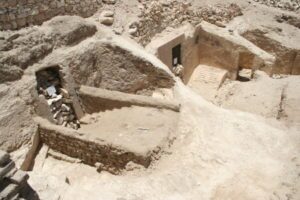
For the past 36 years, from 1975 to the present, The Akhenaten Temple Project (A.T.P), a program initially created to study and reconstruct on paper the dismantled sun-temples of the heretic Pharaoh Akhenaten (14th Century B.C.), has undertaken archaeological work at four major sites in Egypt: At East Karnak (Luxor), where our excavations have uncovered the largest temple of this king; across the river in the Theban necropolis, where we initiated a tomb survey of burials and sepulchres including that of Akhenaten’s butler Parennefer; at Tel el-rub’a in the eastern Nile delta, where we commenced excavation of the ancient city of Mendes; and in the Sinai, a New Kingdom fortress today known as Tel Kedwa. The archaeological field work of the A.T.P. has made significant contributions to our knowledge of all the major time periods of Ancient Egypt, and opened untold opportunities for student participation and training. From 1998, directors, Prof. Donald Redford and Dr. Susan Redford, have combined the work of the project with a field school run under the sponsorship of Penn State Education Abroad, which has been highly successful in training undergraduates, not only in history, but also in the mechanics of archaeological field methodology, epigraphy, recording of reliefs and artifacts, human osteology, paleobotany and conservation. Since field operations always involve native Egyptian labor, students move within the local native community and are obliged to learn a little Arabic. It has been a marvelous opportunity for undergraduates to come into close contact with another important world culture and the Islamic way of life.
The Theban Tomb Survey
One of the most famous antiquities sites in the world, and also among the best explored, is the Theban necropolis. This, Egypt’s second largest ancient burying ground, covers an area of approximately 5.5 square miles on the west bank of the Nile River, just opposite the modern town of Luxor (ancient Thebes) , and encompasses not only tombs, but other substantial monuments such as temple and palace complexes, shrines, and the remains of domestic communities. An incomparable wealth of historic material has been retrieved and continues to be recovered and documented from its environs, providing us with an enormous compendium of information and invaluable insights into most of the major periods of the Ancient Egyptian civilization. The funerary structures themselves are a reflection of political, economic and social conditions of the time. The various cemeteries incorporated within the area range in date from the Old Kingdom through Greco-Roman times, and include those exclusively for royal interments, today known as the Valley of the Kings and the Valley of the Queens, as well as those of the aristocracy, the Valley of the Nobles.
It is the Valley of the Nobles that has been the site of my research for the past 20 plus years. In 1988, I was given a concession by the Egyptian Supreme Council of Antiquities to clear, record and publish three tombs in the Valley of the Nobles, thereby officially inaugurating ‘The Theban Tomb Survey’. While all of the rock-carved sepulchers contracted to my research project were of historical importance, one tomb in particular has commanded the most attention and time and effort throughout my years of digging in the valley. The tomb, numbered 188 in the Theban Tomb registry, is that of the royal butler of the pharaoh, Akhenaten, whose name is Parennefer.
Parennefer’s burial monument is situated in a region of the ancient necropolis known as the Assasif, an area which lies adjacent to Queen Hatshepsut’s temple complex at Deir el-Bahri. Eight field seasons have been spent documenting the decorated walls of Parennefer’s tomb chapel, a task which involved producing facsimile drawings of the scenes and a photographic record, as well as conservation and stabilization of the paintings and structure itself. The monument also required meticulous clearing of five shafts and associated burial crypts that had been discovered within the confines of the tomb; but as anyone who works in the Theban necropolis can tell you, one’s single tomb concession can quite suddenly and unexpectedly broaden. The necropolis is a virtual rabbit’s warren of tomb shafts and ancient robbers’ tunnels that intersect with each other and communicate with unknown interments and often undiscovered tombs buried under slope debris. This turned out to be the case at my Assasif concession which has now expanded west well beyond the boundaries of Theban Tomb 188. The honeycombed shafts in Parennefer’s tomb have led to the discovery of four other previously unknown monuments.
The external entrances of this line of newly discovered tombs situated side-by-side along the cliff terrace, were once completely covered over by slope debris, but have been partly cleared through the efforts of my own team and that of the West Bank Antiquities Inspectorate (fig. 1 below). Much more, however, remains to be done. In cooperation with the Egyptian Supreme Council of Antiquities, the continuation of this clearance operation will be the focus of the Theban Tomb Survey’s 2012 summer expedition. The goal is to fully expose the ancient courtyards of these tombs by freeing the area of accumulated detritus as far as the dirt road on the valley floor (fig. 2 below), and given the expanse of space and some substantial depressions of the topography, undoubtedly more hidden tombs will be uncovered.
_________________________________________________________________________________________
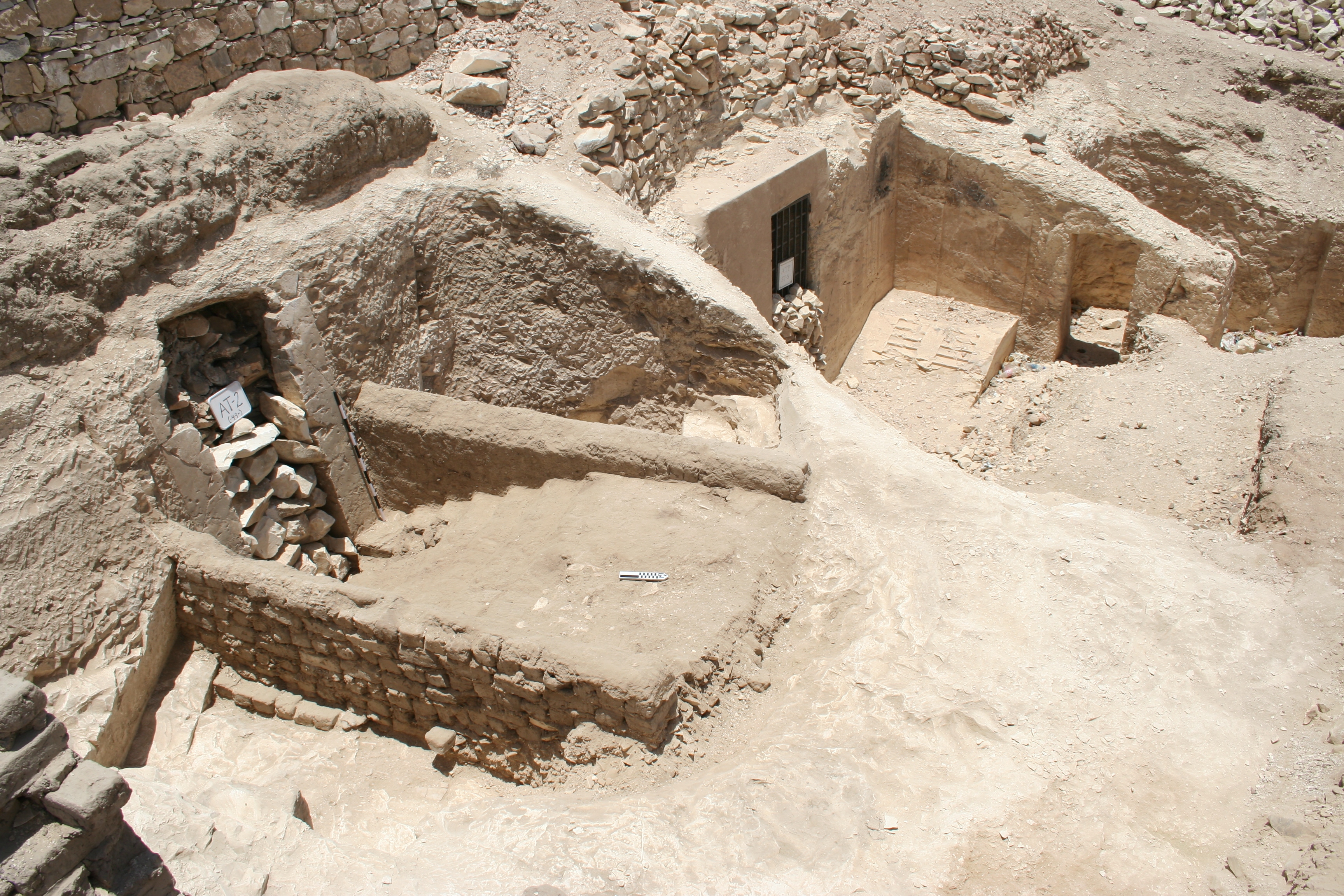 Fig. 1: Entrance and courtyard of one of the newly-discovered tombs of the Assasif concession.
Fig. 1: Entrance and courtyard of one of the newly-discovered tombs of the Assasif concession.
______________________________________________________________________________________________________________________________________________
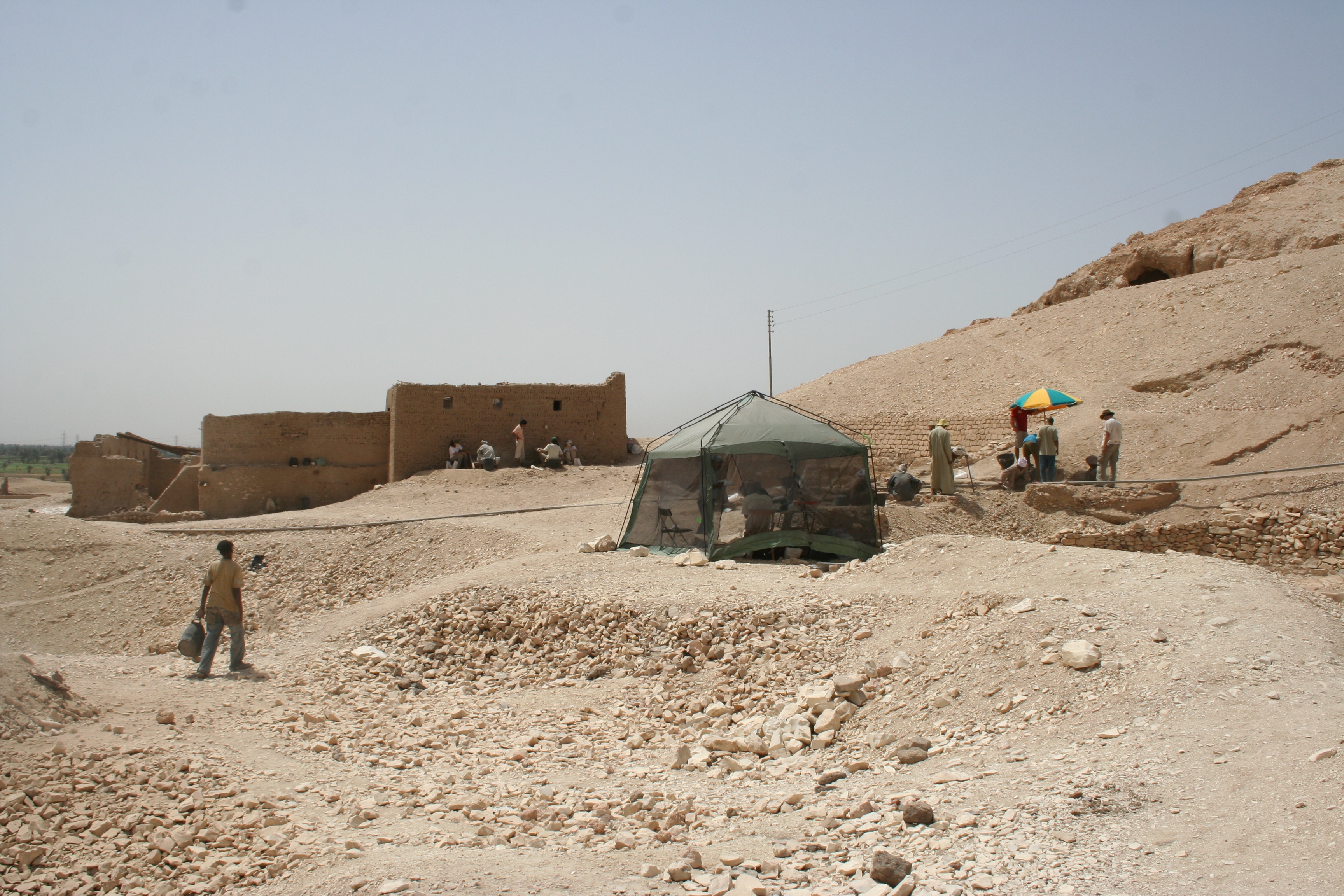 Fig. 2: The slope of limestone debris which will be under excavation in the 2012 field season.
Fig. 2: The slope of limestone debris which will be under excavation in the 2012 field season.
______________________________________________________________________________________________________________________
As in the past, the contents of the slope debris itself will yield important historical information and forensic data. Despite the systematic plundering of the Theban necropolis which continued up to modern times, there is still a tremendous quantity of artifacts from these ancient burials left to be retrieved, as well as human remains. The objects represent burial assemblages that ranged in date from the New Kingdom through to late Ptolemaic/early Roman times, a time period of about 1100 years. Among the types of items collected from our last field season, in which we initiated the clearance of the slope to the immediate west of Parennefer’s tomb, were canopic jars (which once held the organs of the deceased), fragments of painted coffins, pieces of stringed beaded nets and collars, numerous funerary cones inscribed with the names of the deceased, shawabtis (small Osiride figurines of the deceased), amulets, statue fragments and decorated blocks removed from the walls of nearby tomb chapels. Two of the most exciting finds that were recovered were the remains of a cedar coffin with a finely-carved facial mask (fig. 3 below), and a beautiful, limestone relief showing the head and elaborate hairstyle of Parennefer’s wife which had been removed by robbers from the reveal of his tomb’s entrance passage (fig. 4 below).
_________________________________________________________________________________________
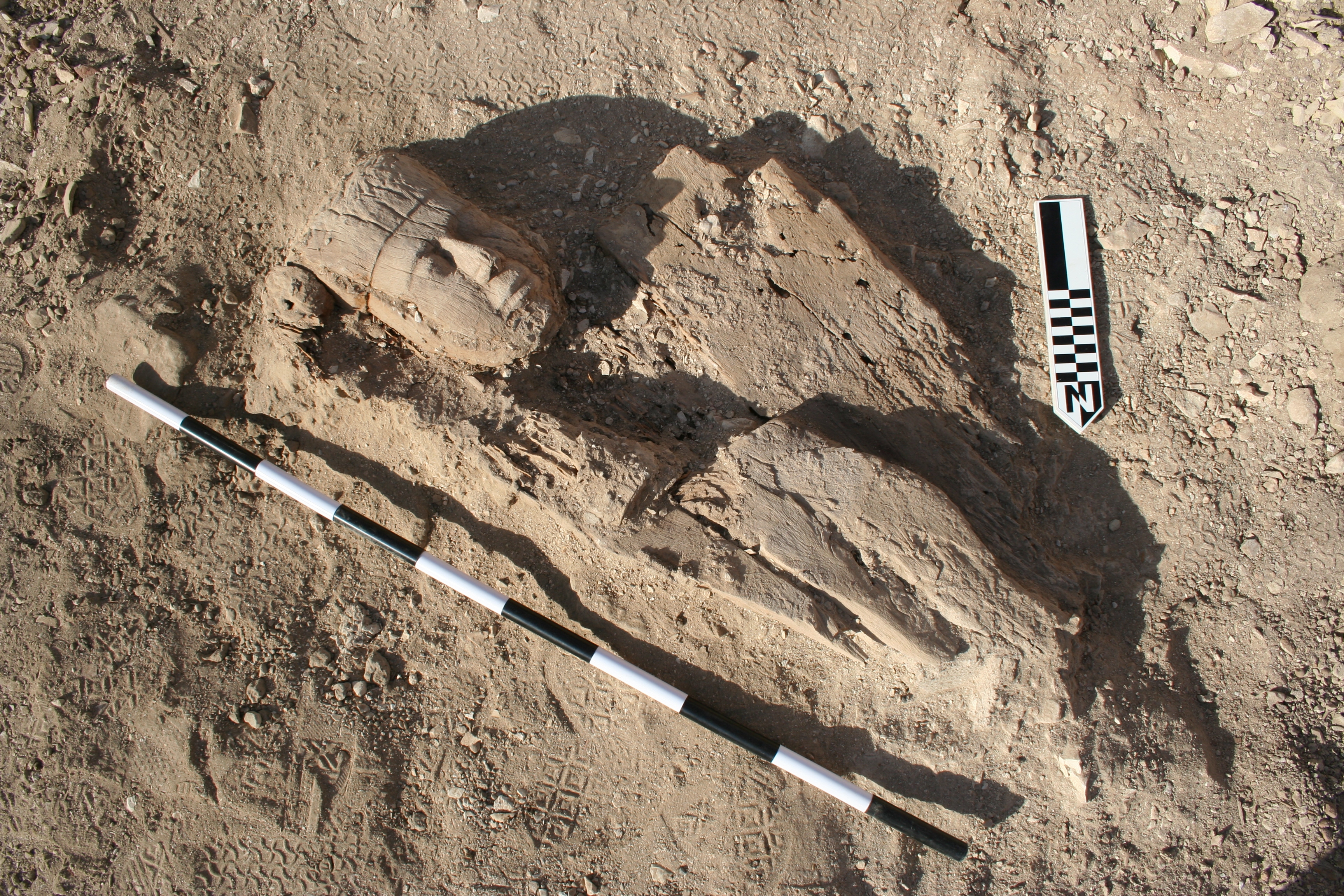 Fig. 3: Remains of a carved cedar coffin discovered by slope clearance in the 2008 field season.
Fig. 3: Remains of a carved cedar coffin discovered by slope clearance in the 2008 field season.
______________________________________________________________________________________________________
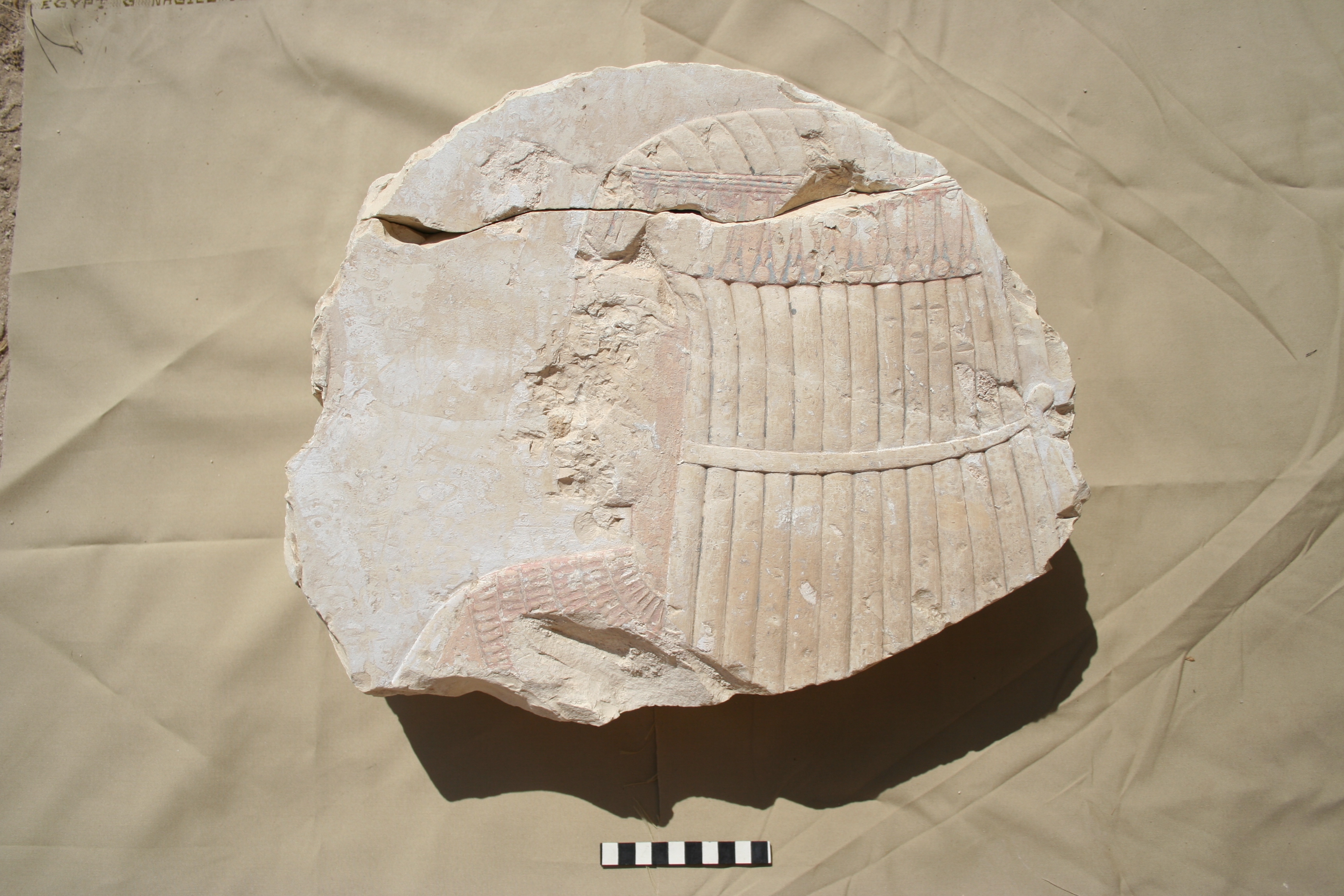 Fig. 4: A block of decorated relief depicting the tomb-owner’s wife removed by vandals from Parennefer’s tomb.
Fig. 4: A block of decorated relief depicting the tomb-owner’s wife removed by vandals from Parennefer’s tomb.
_____________________________________________________________________________________________________________________
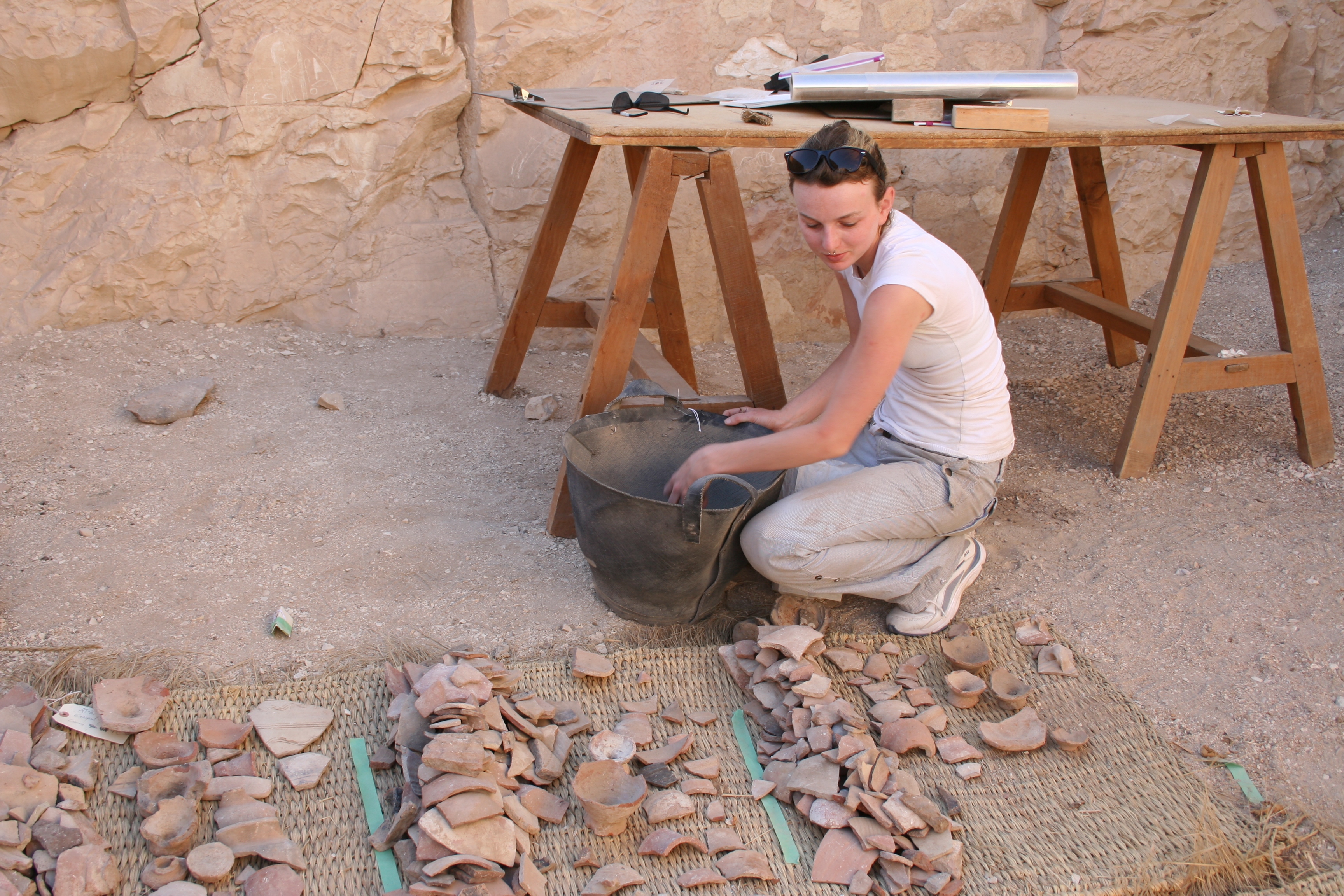 The success and important results of the Theban Tomb Survey have been very much due to a team effort that includes members of my technical staff of artists, photographers, architect, ceramicists, and osteologists,— not to mention the many students that have accompanied us! Besides the hands-on field training that these students have gained, the field school has provided the research project with productive field assistants. Students are involved in all aspects of the field work with tasks that include clearance in controlled excavation, object registration, sifting, osteological documentation, sorting and tabulation of ceramics, assistance with photography and site planning, and general site recording (fig. 5 above right, student sorting pottery “on the mats”). Over the years, students who have joined the expedition have come not only from Penn State, but from other universities across North America, including the University of Toronto, Princeton, Yale, UCLA, New York University, Boston University, University of California, and the University of Hawaii.
The success and important results of the Theban Tomb Survey have been very much due to a team effort that includes members of my technical staff of artists, photographers, architect, ceramicists, and osteologists,— not to mention the many students that have accompanied us! Besides the hands-on field training that these students have gained, the field school has provided the research project with productive field assistants. Students are involved in all aspects of the field work with tasks that include clearance in controlled excavation, object registration, sifting, osteological documentation, sorting and tabulation of ceramics, assistance with photography and site planning, and general site recording (fig. 5 above right, student sorting pottery “on the mats”). Over the years, students who have joined the expedition have come not only from Penn State, but from other universities across North America, including the University of Toronto, Princeton, Yale, UCLA, New York University, Boston University, University of California, and the University of Hawaii.
Susan Redford
The Mendes Excavations
Although the average tourist to Egypt spends almost all of the time visiting the antiquities of Upper Egypt, the Nile Valley, scholarship has long since realized the equal, if not overriding importance of Lower Egypt, the Nile Delta, in ancient times. Here were situated many cities of political, cultural and religious importance, some of which functioned at certain periods of history as the capital of Egypt. Reduced today to ruin mounds of mud-brick rubble, they present a challenge, but also a reward to the diligent excavator. These cities give abundant evidence of Egypt’s relations, military, commercial and cultural, in ancient times with the external world of Phoenicia, Greece and Rome.
For 19 years I have been excavating one of these cities, ancient Mendes, lying in the center of the Nile Delta, midway between Cairo and the Mediterranean coast. The city has been occupied for nearly 5,000 years, and even today could be said to continue to exist in the numerous villages around the ruin mound. Our excavations have demonstrated the existence of human occupation from the prehistoric period, c. 4000 B.C., while the period of state creation, the advent of complex society and the invention of the hieroglyphic script c. 3100 B.C. is well represented. In fact, we have recovered a sequence of very early texts which illustrate the evolution of writing in Egypt. The thousand years of the Pyramid Age, the Old Kingdom, is in abundant evidence with a faunal and palaeo-botanical record that chronicles types of plant cover, land use and faunal population over this uninterrupted time period. The city suffered an abrupt, though temporary, cessation of occupation shortly after 2200 B.C. (confirmed by Carbon-14 dating), when fire destroyed the local temple and a massacre of the inhabitants occurred. When revived in the second millennium B.C. the city featured a large, processional temple, fronted by two pylons, with a long approach flanked by subsidiary temples (fig. 6 below).
_________________________________________________________________________________________
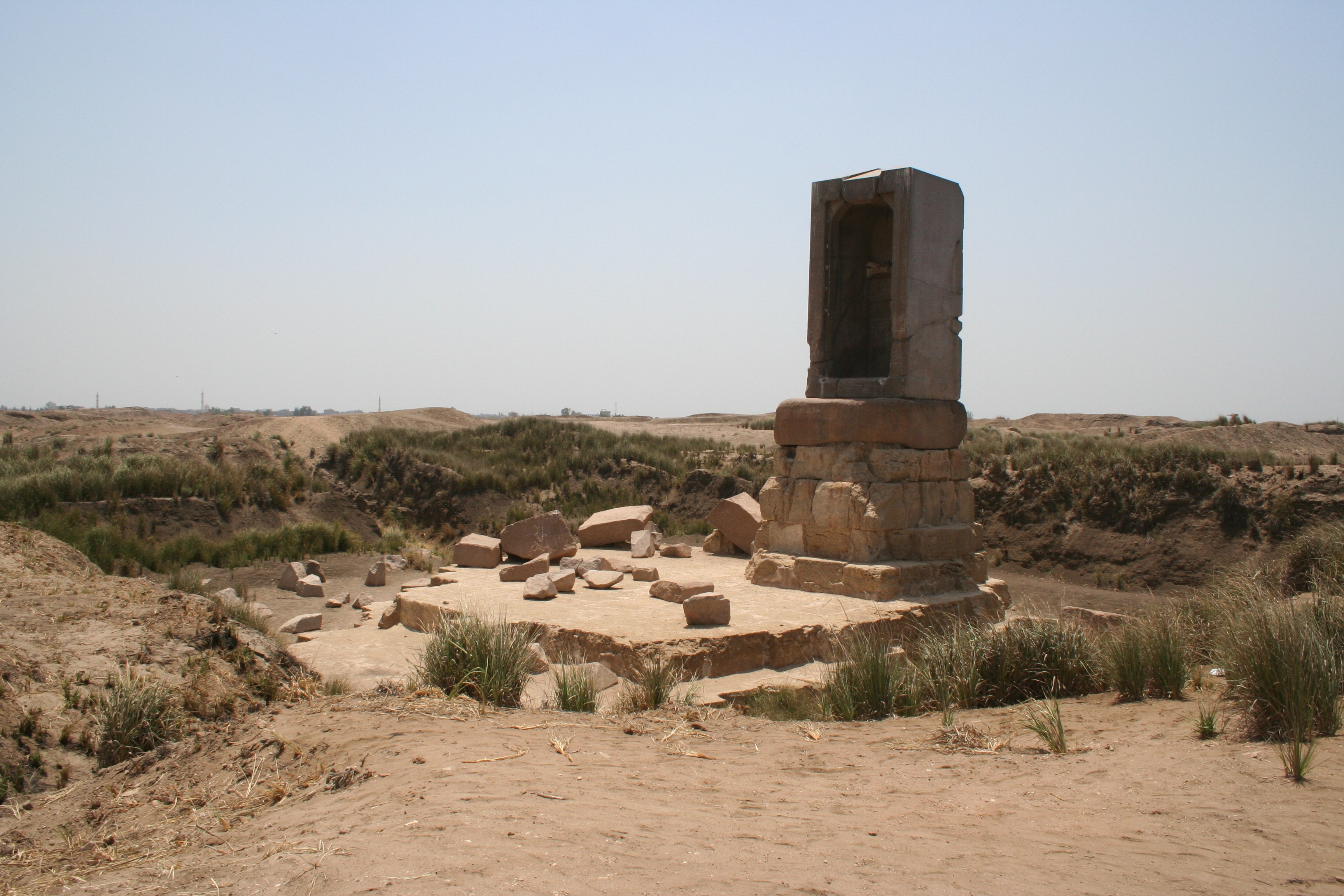 Fig. 6: The Mendesian temple of the Ram-god as it looks today.
Fig. 6: The Mendesian temple of the Ram-god as it looks today.
______________________________________________________________________________________________________________________
From remote antiquity the inhabitants of Mendes had worshiped a ram god and a fish goddess. The sacred rams had been embalmed and laid away at death in a special vault, each in its own diorite sarcophagus. Immature fish of the schilby species, sacred to the fish-goddess, had been placed in pottery vessels and buried in a special part of the city reserved for the purpose (fig. 7 below).
_________________________________________________________________________________________
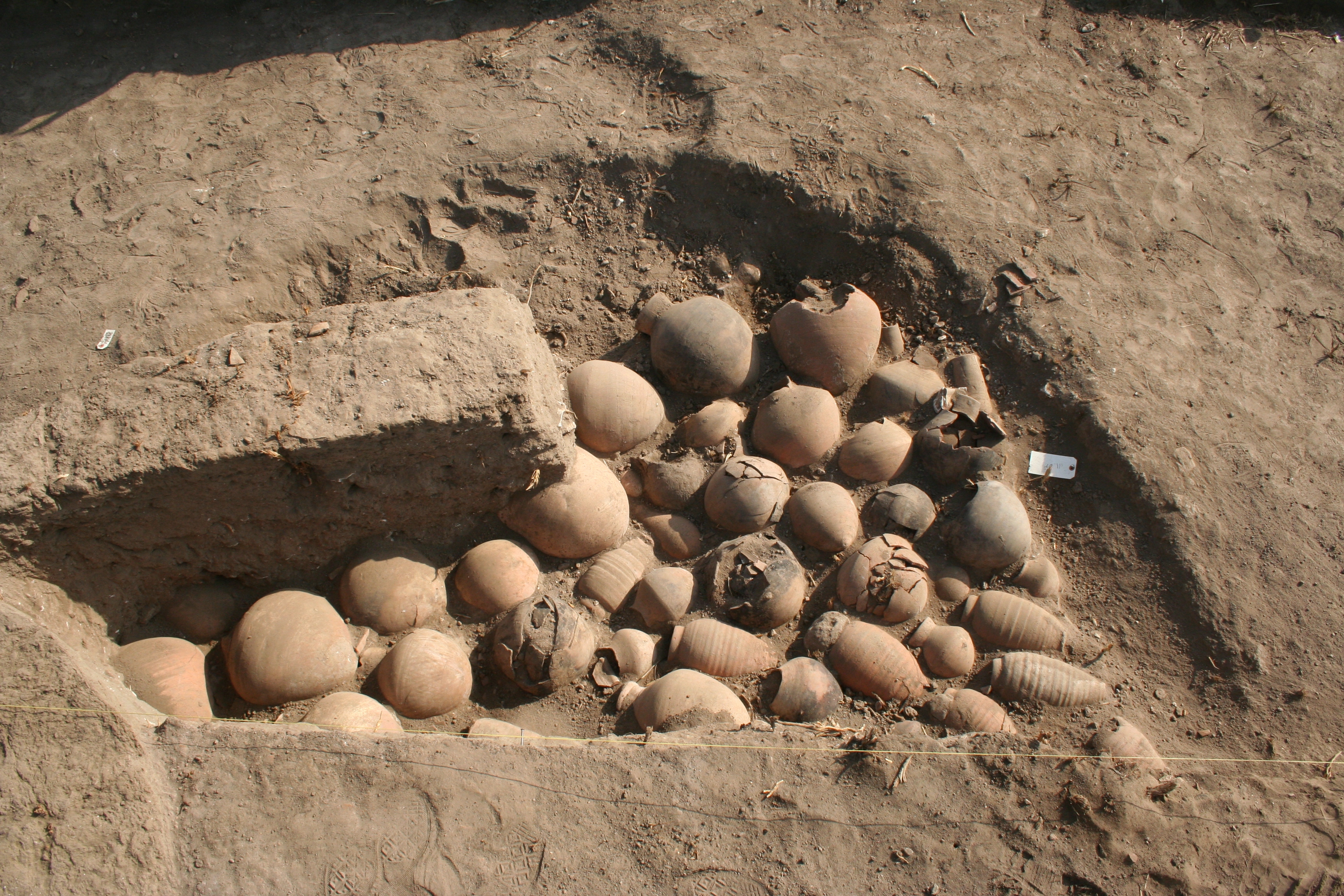 Fig. 7: One of many caches of pottery vessels, each containing the remains of a schilby fish.
Fig. 7: One of many caches of pottery vessels, each containing the remains of a schilby fish.
______________________________________________________________________________________________________________________
Our excavations have identified several harbors at the site, communicating with the local branch of the Nile which provided ready access to the Mediterranean. Storehouses filled with pottery have provided evidence of foreign trade in perfumes (for which Mendes was famous throughout the classical world) and wine with the eastern and central Mediterranean. Sometime approximately in the 7th Cent. B.C. Mendes became the eastern terminus of a new east-west canal, cut across the Delta from the city of Buto in the western Delta, to facilitate commerce and the transfer of troops in both directions. In 399 B.C. the thriving city was the location of a number of families of great political power, and for 20 years Mendes became the capital of Egypt. The tomb of the founder of this (29th) Dynasty, Neferites I (399-393 B.C.), was discovered by our expedition in 1993. Sadly, it was not intact. Neferites had been a Afreedom-fighter, instrumental in liberating Egypt from the yoke of the Persian empire; and when, in 343 B.C. the Persians succeeded in reconquering Egypt, they made a point of destroying his tomb.
After 205 B.C. Mendes began to decline. As the Mendesian branch of the Nile weakened and moved away to the east, the great harbour silted up, and with its demise the commercial basis of life in the city dwindled away. In the first cent. after Christ the city=s population began to diminish and its industry decline; and the town center moved south to what had earlier been a suburb of Mendes. By the 4th Cent. A.D. some of the older temples had been turned into churches.
Mendes is a cross section of Egyptian history. With no villages built over the ruins, it is completely open to our exploration. A fascinating agenda of investigation remains to be acted upon: urbanism in a Lower Egyptian setting, town planning, the distribution of economies, house lay-out. All these themes beckon enticingly!
The expedition is housed in our archaeological institute of 20 rooms, including sleeping and eating quarters, a library, laboratories, draftsmen’s room and pottery work-shop (fig. 8 below). Our professional staff includes historians, palaeo-botanists, faunal experts, physical anthropologists, geologists, ceramicists, all of whom also provide hands-on training to our student participants (fig. 9 below). (Not all our researchers are on staff during a single season, being present when our program goals require their expertise). Areas of research this coming season of 2012 will include: (a) the clearance and partial restoration of a Temple built by Amasis (569-526 B.C.); and (b) excavation of houses of the period 2300-2200 B.C.
Donald Redford
_________________________________________________________________________________________
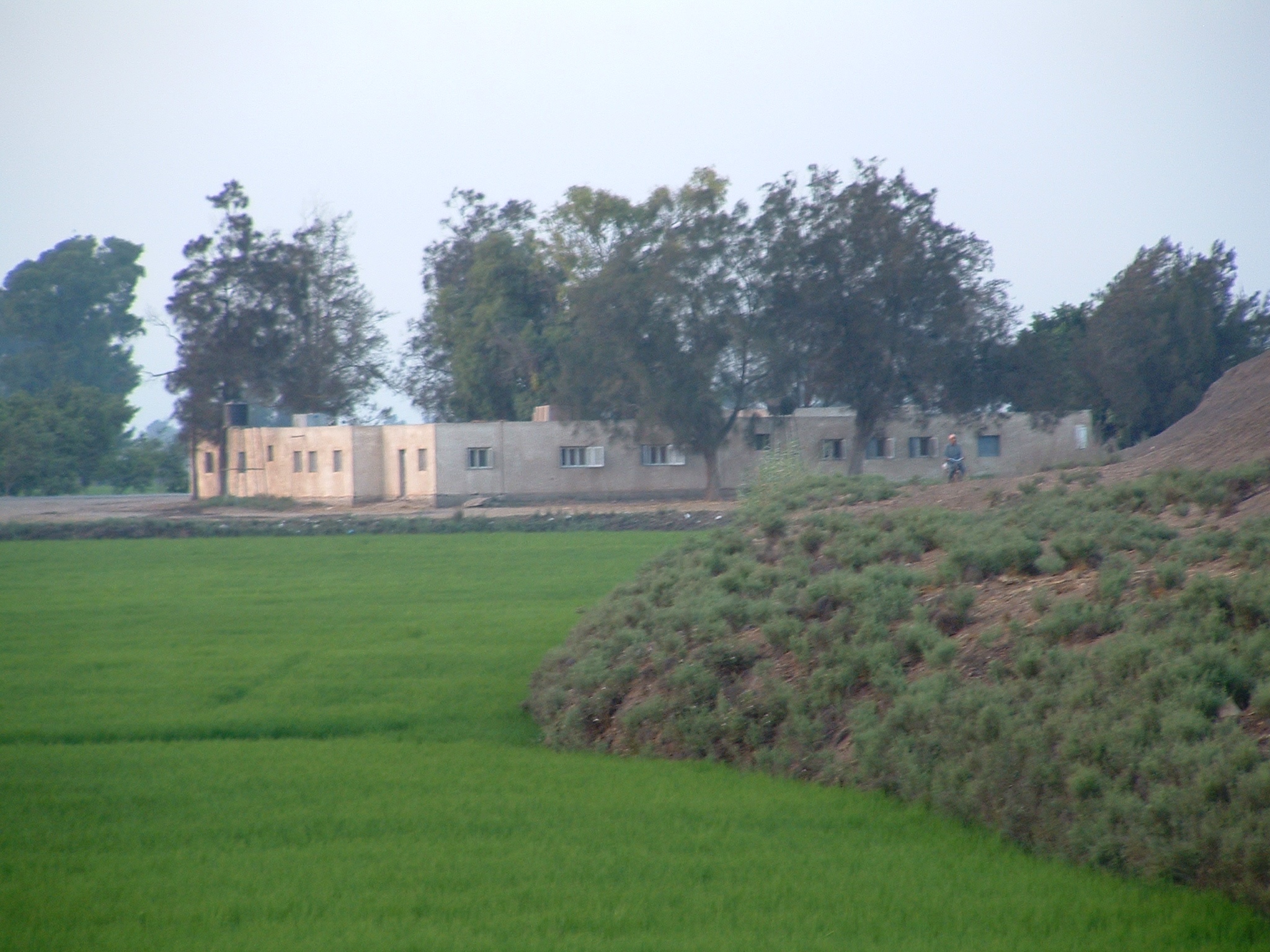 Fig. 8: The Mendes expedition house
Fig. 8: The Mendes expedition house
______________________________________________________________________________________________________________________
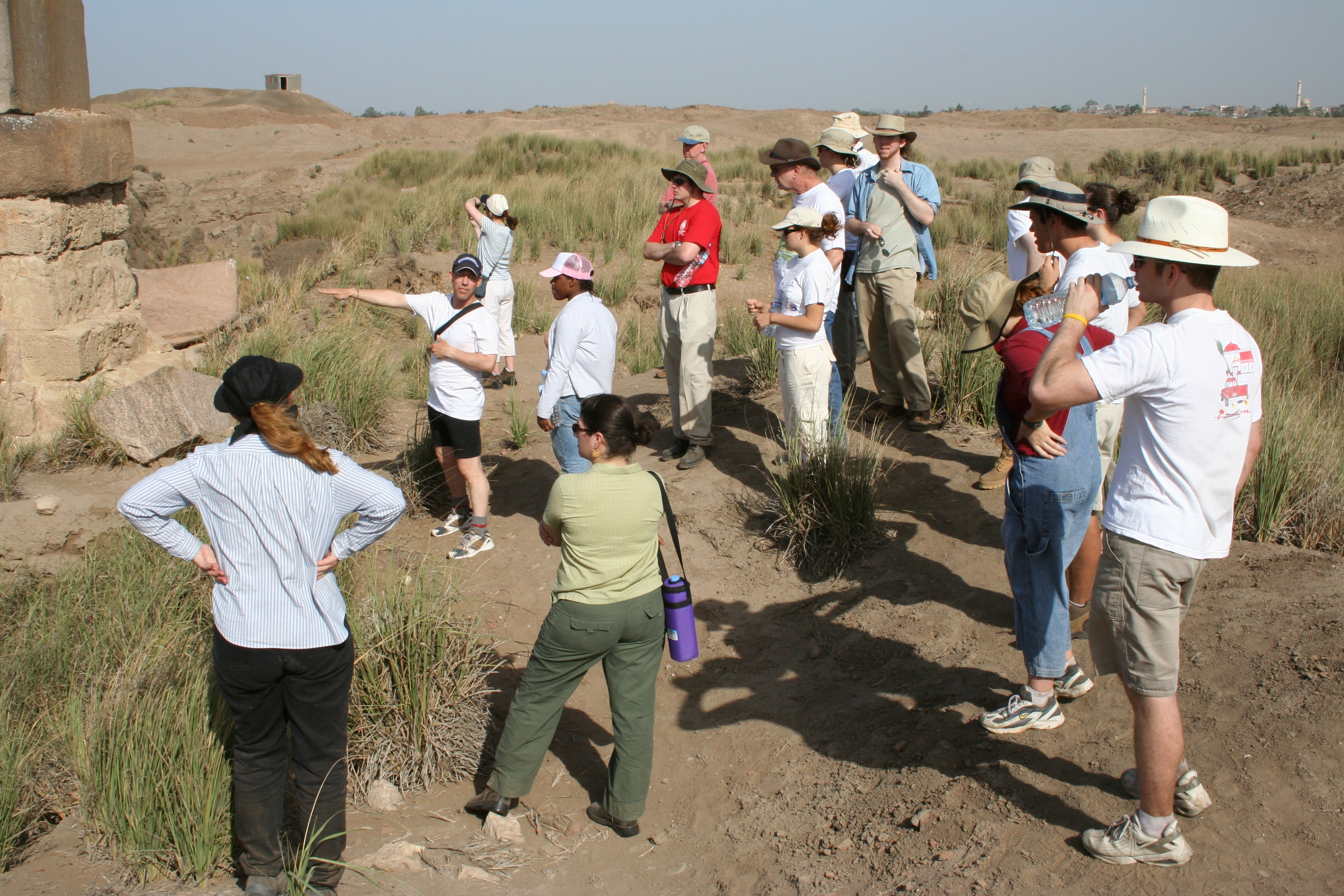 Fig. 9: The 2010 Mendes team.
Fig. 9: The 2010 Mendes team.
______________________________________________________________________________________________________________________
How You Can Help
Penn State’s Summer Abroad field school offers students six credits in the area of archaeology, ancient Mediterranean studies and international cultures toward their degree. Those who are interested in taking part in this exciting research and gaining a memorable cultural experience can submit an application on-line at www.outreach.psu.edu/summerabroad/study-egypt for the up-coming 2012 expeditions.


